What does a pseudo-pro triathlete’s training look like? I know you’re dying to find out, so I put together a year-end review! Actually, it’s mostly for my own benefit, but maybe you can glean something useful or berate me for doing it all wrong. At the very least, you’ll get an idea of what it takes to hack it as an elite age grouper going pseudo-pro.
Be warned, there will be more plots than your mom’s daytime soap opera.
When reviewing your training or another athlete’s, you should always ask yourself if an outcome was the result of a certain approach, unrelated to it, or in spite of it. Causation and correlation are often a tangled web. It’s also a mistake to assume that someone else’s approach will deliver the same results in your case. We’re all snowflakes… or whatever.
I won’t beat you over the head with my racing exploits. Suffice it to say that 2013 was a breakthrough season and 2014 will bring new challenges. What I will do is provide an overview of my training with some insights into my approach in each of the three disciplines.
Here’s a pie chart to whet your appetite:

My training philosophy
As I enter my third year focusing on triathlon, I’m approaching the point where I can’t train a whole lot longer or harder. Continued improvement requires more effective and efficient training. I continually go about streamlining my training by asking myself the following questions: What is the purpose of this practice? How does it benefit my performance? If I can’t readily find answers, it goes on the chopping block. Here are some things I’ve cut over the past few years:
- all sports other than swimming, cycling and running (i.e. cross-training)
- almost all strength training with the exception of a minimal, targeted core routine
- almost all easy swims
- all drills in swimming, cycling and running
- all “active recovery” rides (power below Zone 2/Endurance)
- most bike-run brick workouts
That’s not to say that these things are without value. However, if I couldn’t make a compelling case for the benefits after consulting a variety of sources, I decided that my time and energy could be better spent elsewhere.
I like to think that I take a no-nonsense approach to workouts. Pretty much all my workouts are of the form X × Y with Z rest, where X is a number and Y and Z are distances or times. I’m skeptical of “secret sauce” workouts that take more than a sentence or two to describe. I repeat a handful of simple workouts very often. I also avoid epic workouts in favour of solid, unspectacular ones. The former make for impressive social media posts, but the latter lead to consistency.
While I appreciate the inherent complexity of triathlon, I believe that the tricky part lies in periodization across three sports, not in the day-to-day minutiae of training. It’s about hitting the right training load in each of the three sports and stressing the right systems at the right time, not performing some magic sequence of intervals two weeks before a race. The complexity isn’t in coming up with workouts, but knowing how they fit into a season.
2013 Training Summary
Here are some key stats for 2013*:
|
Swim
|
Bike
|
Run
|
Total
|
|
| Volume, weekly avg. hours (min – max) |
4.4
(2.1-10.7) |
9.0
(1.8-16.5) |
5.7
(2.6-8.6) |
19.6**
(12.2-26.5) |
| Volume, avg. hours/session Biggest day (hours / km) |
1.2
(2.9 / 10.1) |
1.7
(5.2 / 177) |
0.9
(2.2 / 31) |
1.3
(6.3) |
| Frequency, avg. sessions/week*** (min – max) |
3.8
(2-8) |
5.3
(2-9) |
6.1
(3-10) |
15.1
(10-23) |
| Days off, total (most consecutive) |
173
(3) |
77
(2) |
80
(3) |
2
(0) |
*My training hours strictly include actual moving time, no shoelace tying, bathroom breaks, lollygagging, etc.
**Total volume also includes a minimal strength training routine (avg. 35 minutes/week).
***Workouts or races consisting of more than one sport were counted as multiple sessions (e.g., triathlon = 3 sessions). Workouts shorter than 15 minutes and strength workouts are not included in frequency.
I track my training and other metrics using a spreadsheet-based system that I have evolved over the years. I prefer it to commercial training logs because I can collect, import, export, organize and analyze any data any way I can imagine. This also gives me unrestricted ownership and access to my data, allowing me to port it to whichever platform I choose in the future. For cycling power file analysis, I use the free, open source software Golden Cheetah. I also upload some workouts to my Strava account.The graph below shows my weekly training volume in each sport throughout the year.
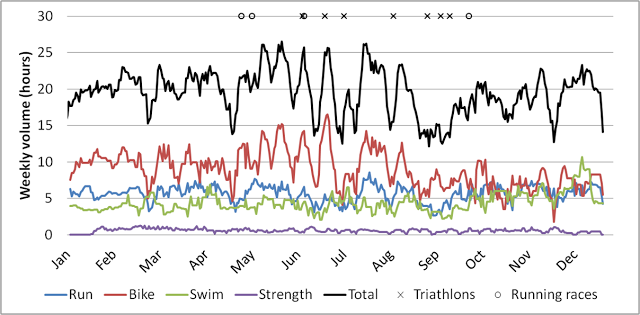
One thing that should strike you is that I trained between 15 and 25 hours pretty much every week of the year. While this shows a type of consistency, it also indicates room for improvement in periodization. The truth is that I feel off track unless I’m training 20+ hours a week. I have been guilty of clinging to a somewhat high level of fitness year-round rather than embracing the cycle of building, peaking and downtime—the ebb and flow of form and fitness—that promote recovery and maximize performance. This year, I’ll be aiming for more weeks around 30 hours and under 10 hours. Both will take discipline!
Here’s my training volume aggregated into months:
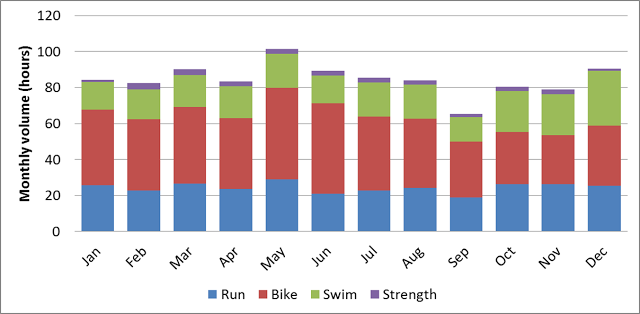
I’m focusing on volume in this post, but in fact, I hardly pay any attention to volume. For planning and analysis, I usually focus on training load (a function of volume and intensity). This year, I estimated training load using an arcane system based on perceived exertion. I’m in the process of switching to a more objective and scientific system based on Training Stress Score (TSS) (and related concepts: ATL, CTL, TSB). The science behind TSS is still a little sketchy, particularly for running and swimming, but it’s an improvement.
Swimming
For most of 2013, my swim volume was a little lower than previous years, but I still saw solid improvement.
- 2013 highlights: low 19 minute (<1:18/100m) Olympic swim splits without drafting (Bracebridge in August, Lakeside in September)
- 2012 comparison: never broke 1:20/100m in short course triathlons
I made better use of my time in the pool by eliminating practices with low or questionable value. For me, these included most easy swims, drills, continuous swims and long cool-downs.
In the past, my goal was to complete longer and longer sets on shorter and shorter pace times. I got to the point that I could do long sets on a 1:30 base, but my threshold pace had plateaued at 1:20-1:22/100m for a couple years. I had become more efficient at that pace, which is certainly helpful for triathlon, but I wasn’t getting much faster. I realized that my approach was backwards; I should be prioritizing higher quality swimming (both speed and technique), before bringing down pace times. Now I spend as much time as possible swimming under 1:20/100m holding good technique, even if it means doing shorter sets with longer recovery.
Recommended read: The Top 20 Rules for Faster Triathlon Swimming by Joel Filliol
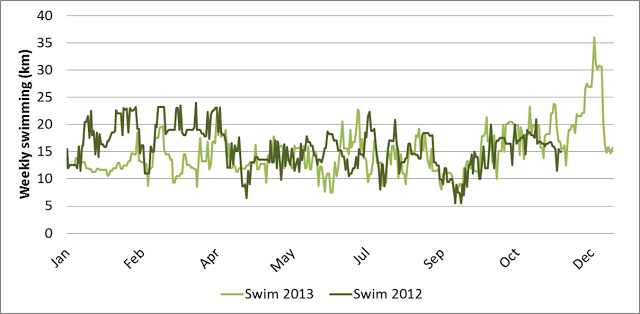

Cycling
Cycling was by far my weakest discipline in the past, making it the obvious focus for 2013. I revamped my bike training and was rewarded with progress nearly every month of the year.
- 2013 highlights: 2:11 (41.1 km/h) half iron bike split PR (Welland in June), sub-1 hour (>40 km/h) Olympic bike splits, FTP ~4.8 W/kg
- 2012 comparison: <39 km/h in all short course triathlons, 1:02+ Olympic bike splits
Here are six ways I changed my bike training in 2013:
- Riding consistently and with purpose every week of the year.
- Breaking up my solo training with challenging weekly group rides of 90-180 km with triathlon-specific workouts (i.e. not draft-fests).
- Buying a power meter in July. I was once a power skeptic, but I have seen the light. Hallelujah!
- Acquiring a CompuTrainer in October. Since then, my FTP has continued to improve despite a 40% reduction in outdoor/mid-season cycling volume.
- Building a cross bike. It may be a very different beast than a thoroughbred race bike, but my hip angle is close enough to my tri position to maintain specificity. Riding quiet, sheltered trails and dirt roads provides an escape from the grind of my usual paved routes, traffic and wind. I ride more as a result.
- Racing 5-10 lbs heavier than 2012. Coming from a BMI of ~19 in 2012 to 20+ in 2013 put me more in line with the top long course triathletes (1, 2) and cyclists (3, 4; excluding climbers and dopers).
Recommended read: Training and Racing with a Power Meter by Hunter Allen and Andrew Coggan
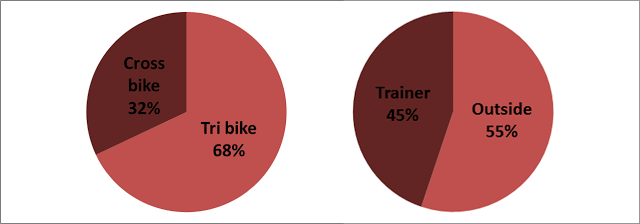
Running
Running, my strongest discipline, was on the back burner this year. Run workouts were rarely done on fresh legs and were the first to get cut. As a result, I didn’t see across-the-board improvement as in cycling and swimming.
2013 highlights: two 1:17 half iron run splits in the heat (Welland in June) and hills (Muskoka 70.3 in September), 49:38 15k PR (Billy Taylor in April)
2012 comparison: sub-33 minute 10k Olympic run split PR, 50:59 15k
A typical week was anchored by three key runs: two workouts of 75-90 minutes, usually a tempo run and intervals or hill repeats, and a long run of about 2 hours. Sometimes I scratched a workout and included some quality during my long run instead, particularly during the build up to half iron races. Between key sessions, I did a lot of short, easy runs to keep frequency high, including many 15 minute commutes to and from the pool. I run on trails and dirt roads as much as possible, which has likely contributed to my spotless injury record.
Triathlon finances
This year I’m going to keep track of all my triathlon-related revenue and expenses with the goal of breaking even in my first season as a “pro”. I’m going to cheat a little by not amortizing the cost of currently owned equipment and not factoring in lost revenue from my day job. Look for a “pro” triathlete budget next year!
- Revenue: $1,825 (includes prize money and cash sponsorship, does not include in-kind sponsorship)
- Expenses: ?
- Bottom line: 4 figures in the red
Other stats & graphs
- Solo training: 90%+
- Injuries: ZERO
- Illnesses: ZERO
- Naps: ~365
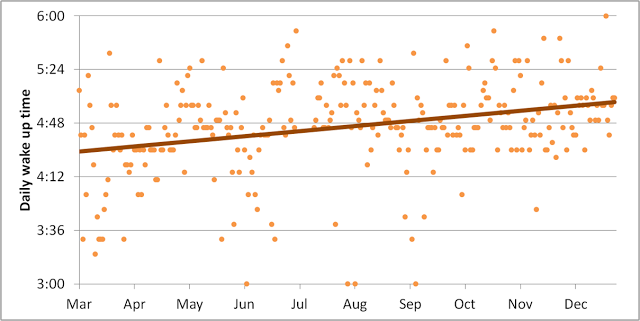 |
| Daily wake up time in 2013 with a linear regression. Chronic early morning insomnia was once a major performance limiter for me. My average wake up time was 4:45 AM in 2013, trending in the right direction. Read more: How I Kicked Chronic Insomnia |
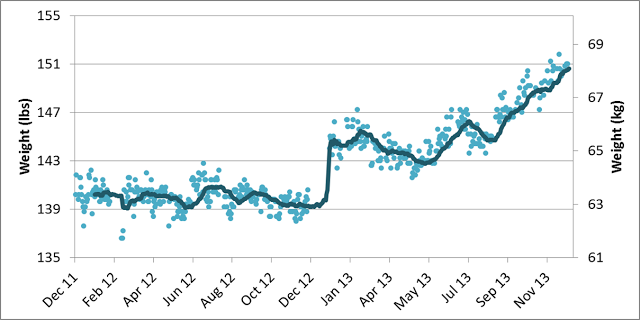 |
| Daily weight in 2012-2013 with a 30 day moving average. Following a brush with overtraining syndrome in December 2012, I deliberately gained 5 then 10 lbs and continued to see performance improvements. Next season, I will likely race around 150 lbs/68 kg at 6 ft/183 cm tall. Read more: Fatter & Faster? Finding My Racing Weight |







